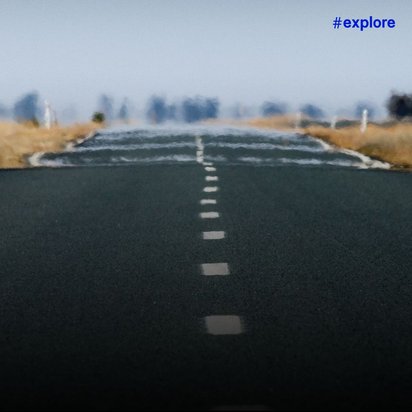Good question, next question
Why does the air shimmer in the summer?
From Shimmering Air to the Fata Morgana

Good question, next question
From Shimmering Air to the Fata Morgana

10 August 2023
We imagine driving in an air-conditioned car. How do we recognize that it’s summer outside? Perhaps by the golden wheat fields or the airy clothing of others. And certainly by the shimmering air above the hot asphalt. But why does the air seem to get stirred up in the summer?
When Thelma and Louise are fleeing through the Arizona desert in the cult film, the air shimmers above the highway. And we know: It’s really hot here. This is a phenomenon we can also observe on a country road in Brandenburg or Baden-Württemberg. The physical reason: The sun’s rays heat the dark surface of the road and the air directly above it. The warmed air expands, becomes lighter, and rises. In some places, it does this faster, in others slower. Sometimes, the hot air mixes with the cooler air above it. This makes it heavier again, causing it to sink back to the road surface, where it is heated again and becomes lighter. This constant up and down, along with the mixing of hot and cold air, creates air vortices. These vortices deflect the light on its way to our eyes.
The cause of this is the different density of warm and cold air: In one liter of warm air, fewer molecules are moving around than in one liter of cold air. Therefore, light rays pass through the warm air more easily, while in colder air, they face more resistance. The rays are traveling at different speeds in differently tempered air masses. This speed difference causes them to bend at the boundaries between warm and cold air. With the swirling air, this bending happens repeatedly. We perceive the landscape behind the turbulent air layers as distorted and blurry: it shimmers.
We can also observe this phenomenon above a hot grill, behind the engines of a jumbo jet, or over open flames, whether from a candle, a gas stove, or a campfire. Only when it’s windy does the shimmer disappear because the hot air layers over the road are blown away, preventing the swirling of different air temperatures.
When light rays hit a differently tempered air layer at a particularly shallow angle, they are not only refracted but totally reflected. This creates a mirage, a Fata Morgana: In the desert sand, a large lake seems to spread out just before the horizon, but as you approach, it dissolves into nothing. The promised water source is actually just a reflection of the sky. But even in our latitudes, we can regularly marvel at Fata Morganas: when puddles seemingly form on the scorching hot country road in summer, in which even cars are reflected.
When it’s particularly hot, the warmer and cooler air layers meet high above the ground. In this case, the Fata Morgana is visible in the sky above the horizon. The reflection can even bring distant objects seemingly within reach: palm trees promise shade, or buildings shelter, but are actually hundreds of kilometers away.
For a Fata Morgana, no heat at the ground is needed, just differently tempered air layers and a long, flat stretch over which light can spread at a shallow angle. That’s why air mirages occur not only in deserts and on roads but also in the Arctic or over the sea.
Over the ocean’s water desert, the temperature relationships are reversed compared to the Sahara: it’s cool below and warmer above. The mirage of an oil tanker is often seen above the horizon line and often upside down. Through multiple reflections, the ship may appear upright, distorted, enlarged, or even seem to float in the air. The legend of the Flying Dutchman – the cursed sailor who endlessly haunts the seas – may have its origins here.
By the way, the name of this physical phenomenon comes from the sister of the legendary King Arthur: the fairy Morgaine. She is said to have lived on a magical island, unreachable for mortals, in the Strait of Messina, between Italy and Sicily. This is likely why she became internationally known by her Italian name: Fata Morgana.
This is an article from #explore. #explore is a digital journey of discovery into a world that is rapidly changing. Increasing connectivity, innovative technologies, and all-encompassing digitalization are creating new things and turning the familiar upside down. However, this also brings dangers and risks: #explore shows a safe path through the connected world.